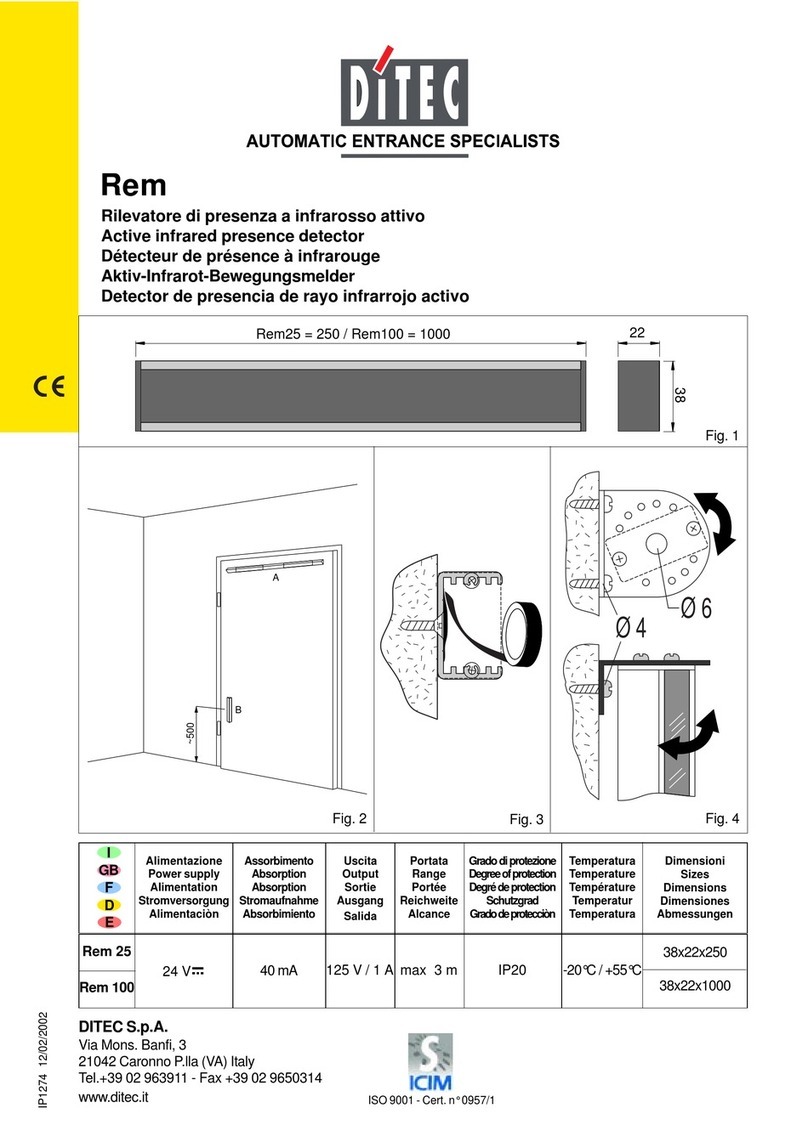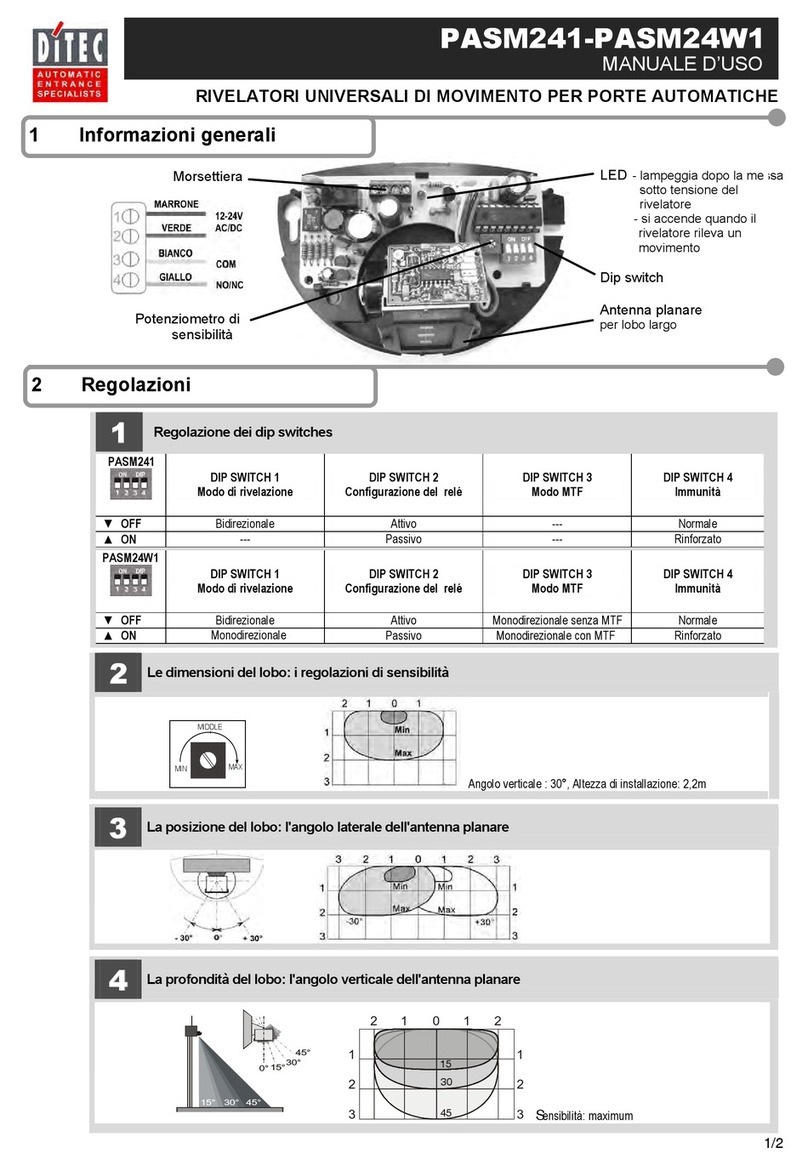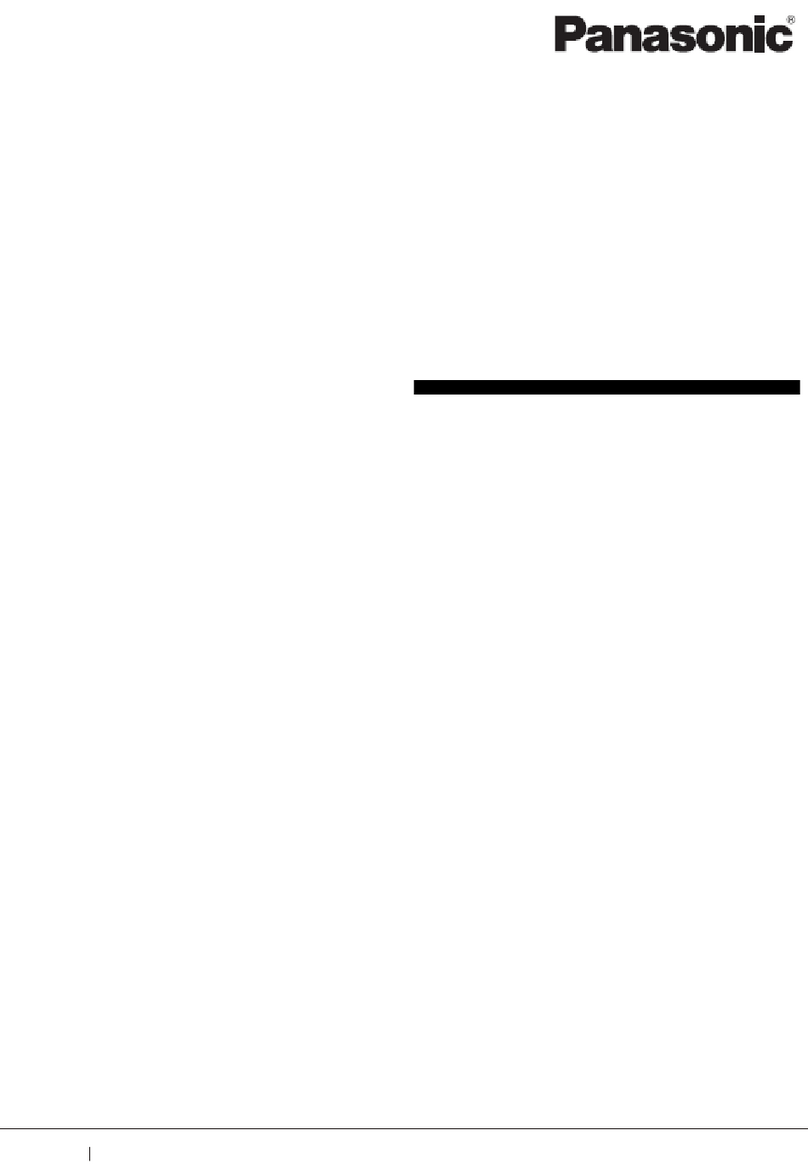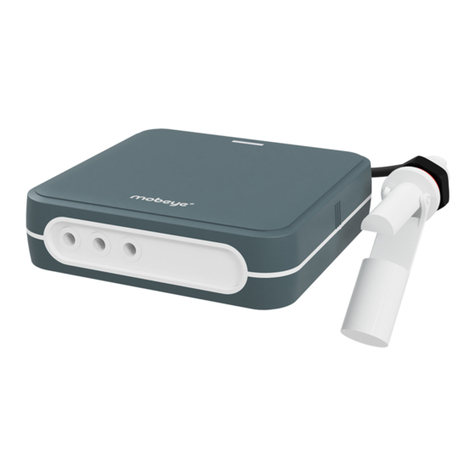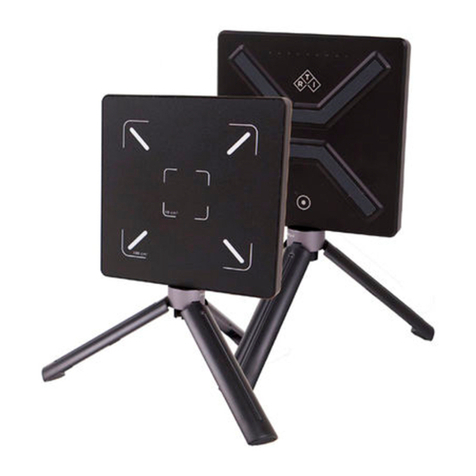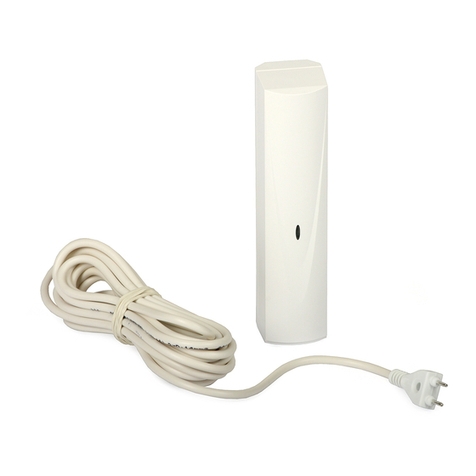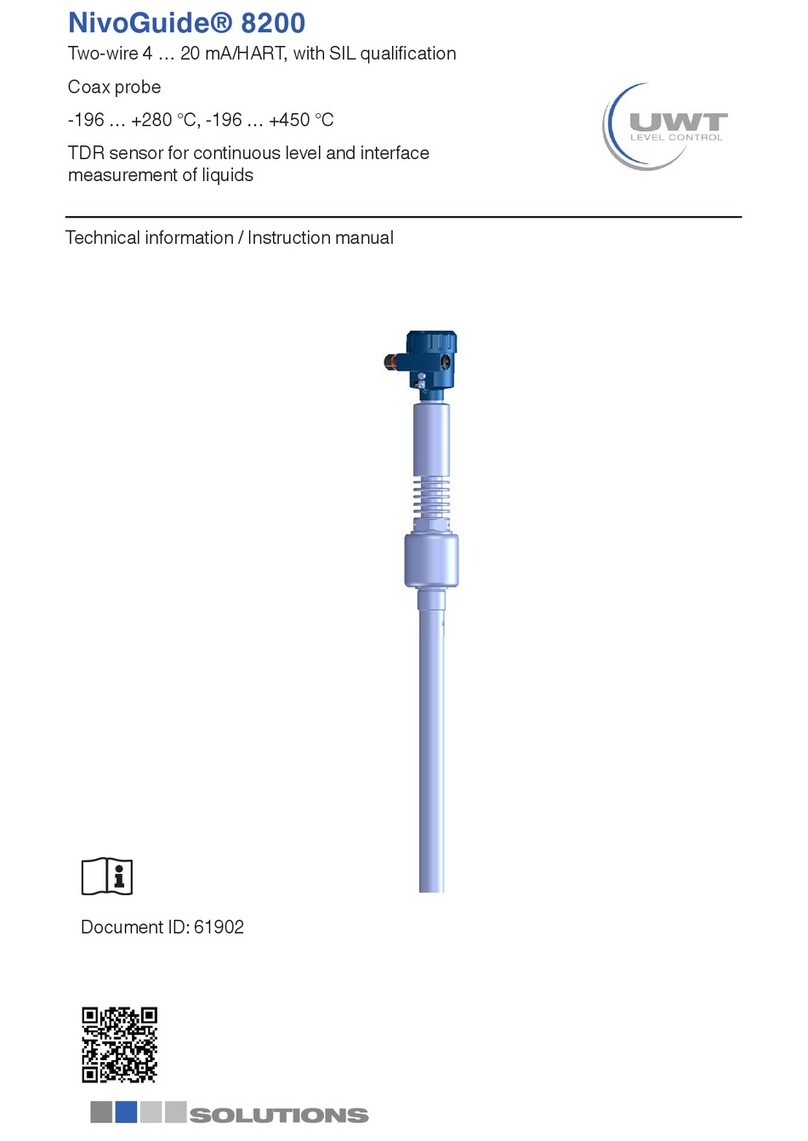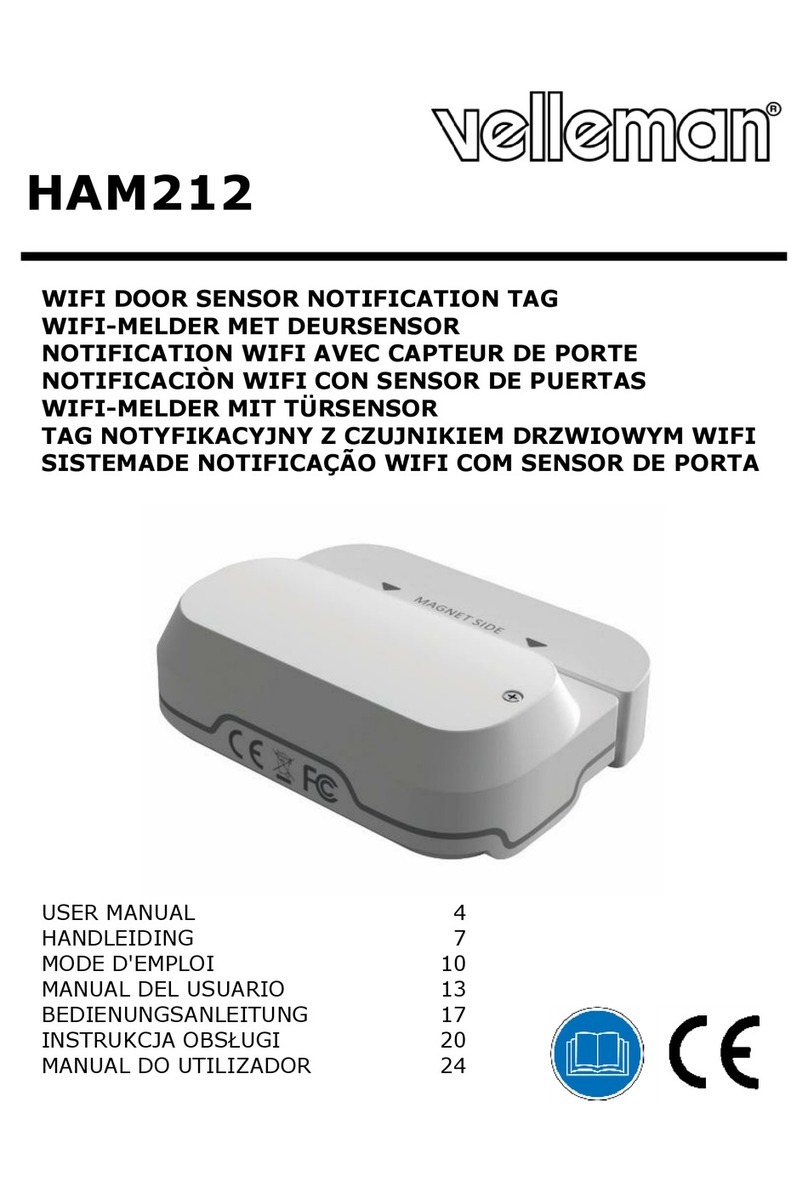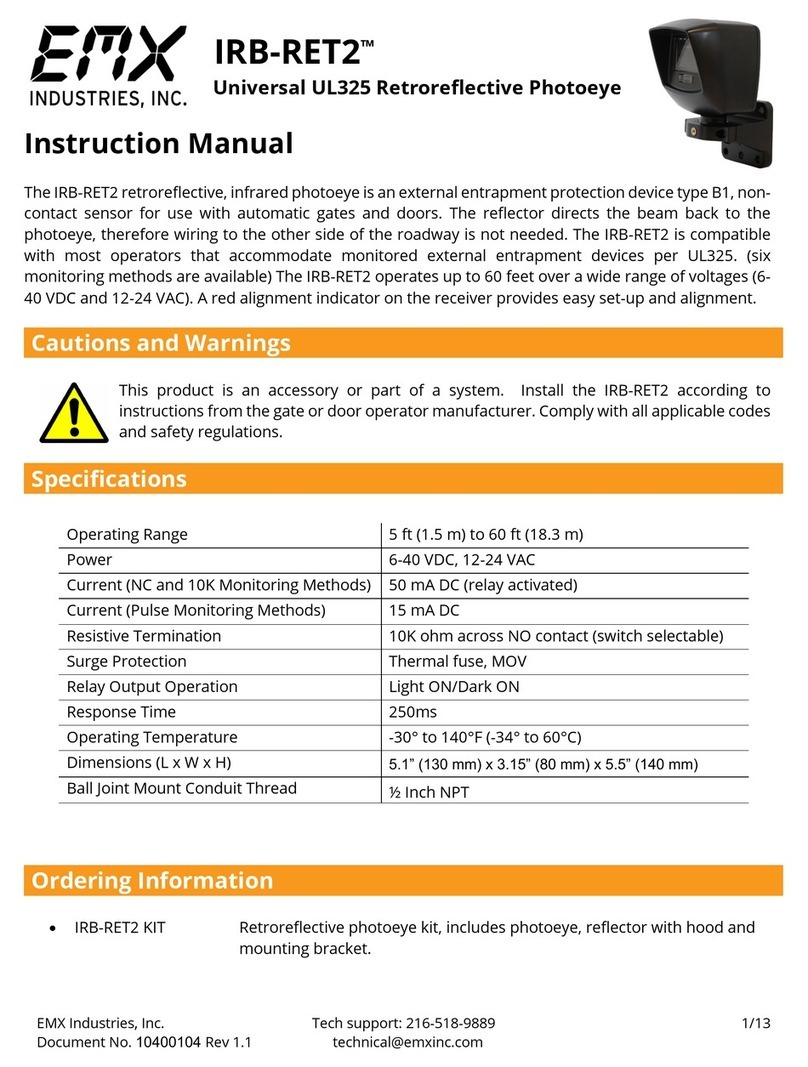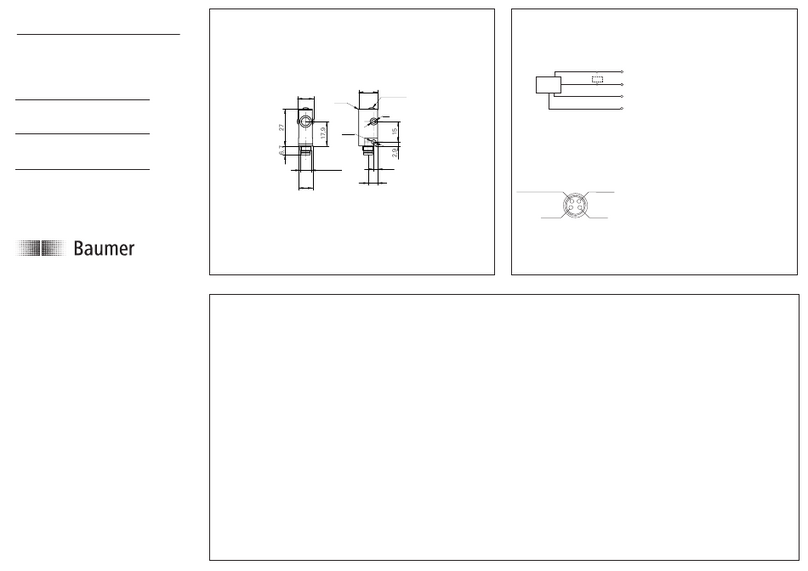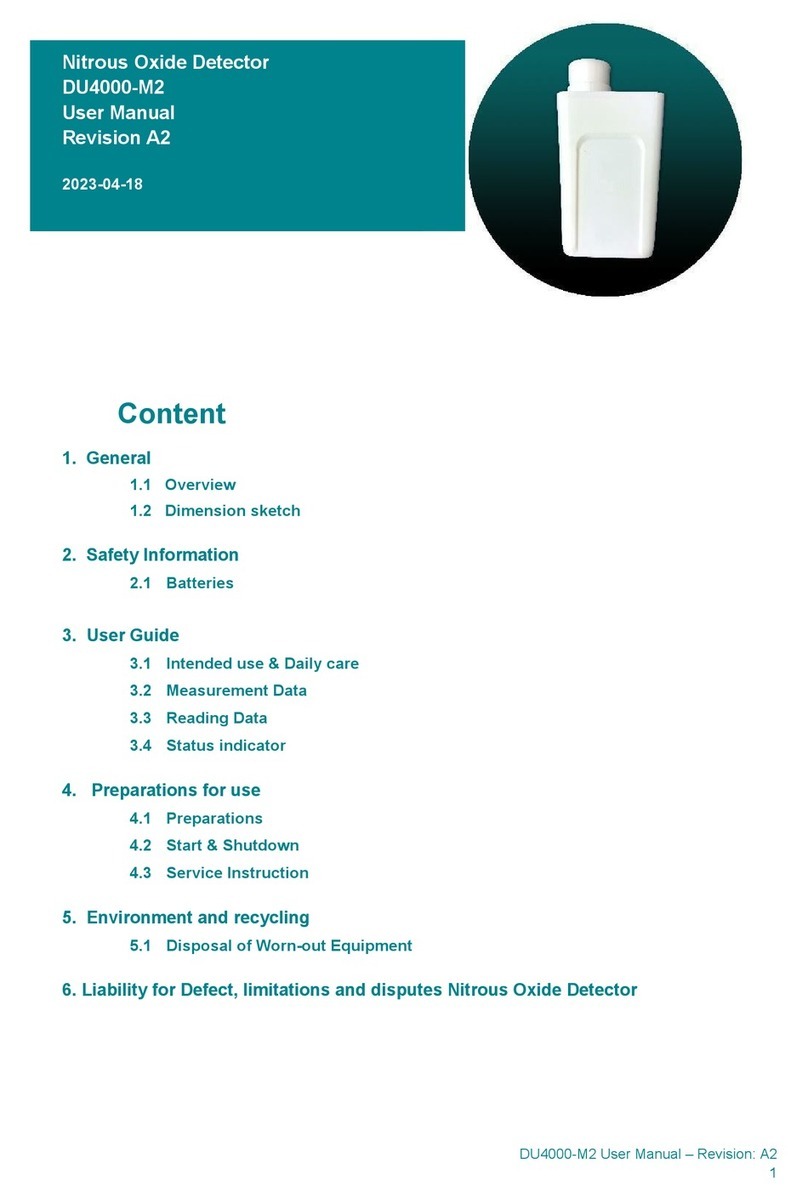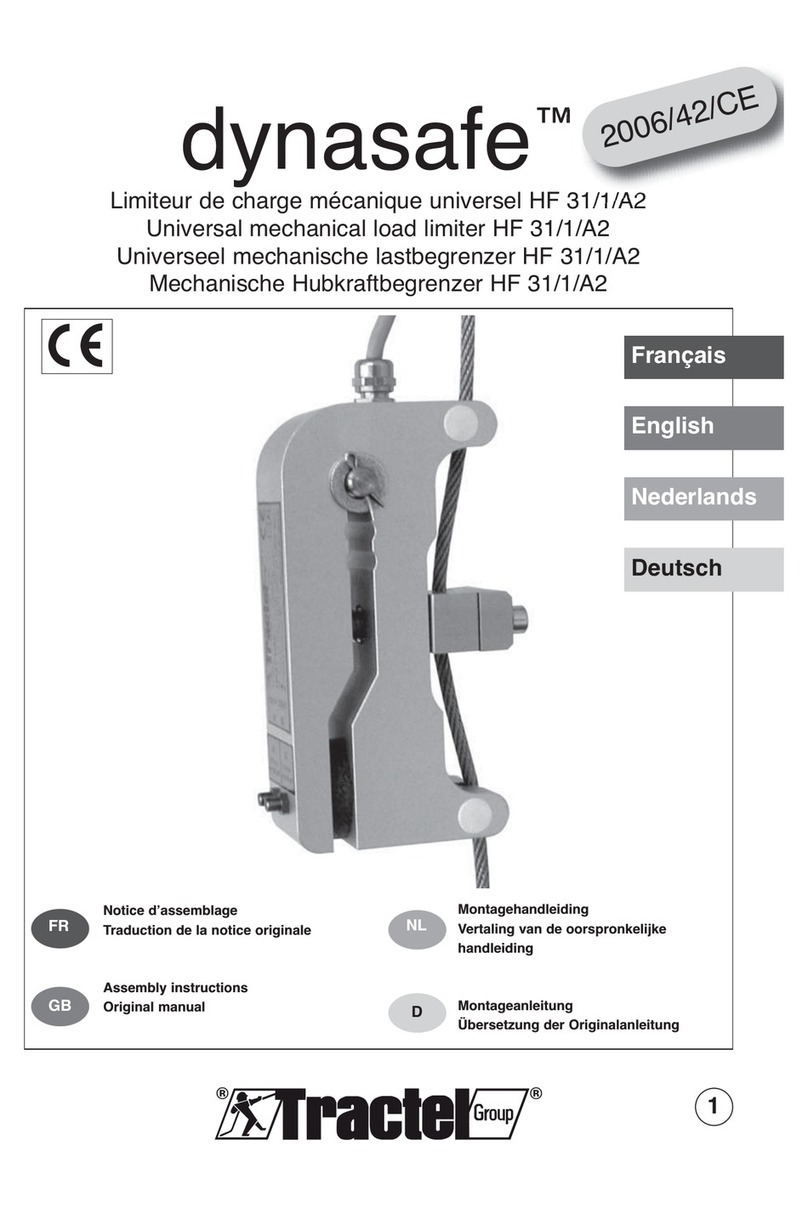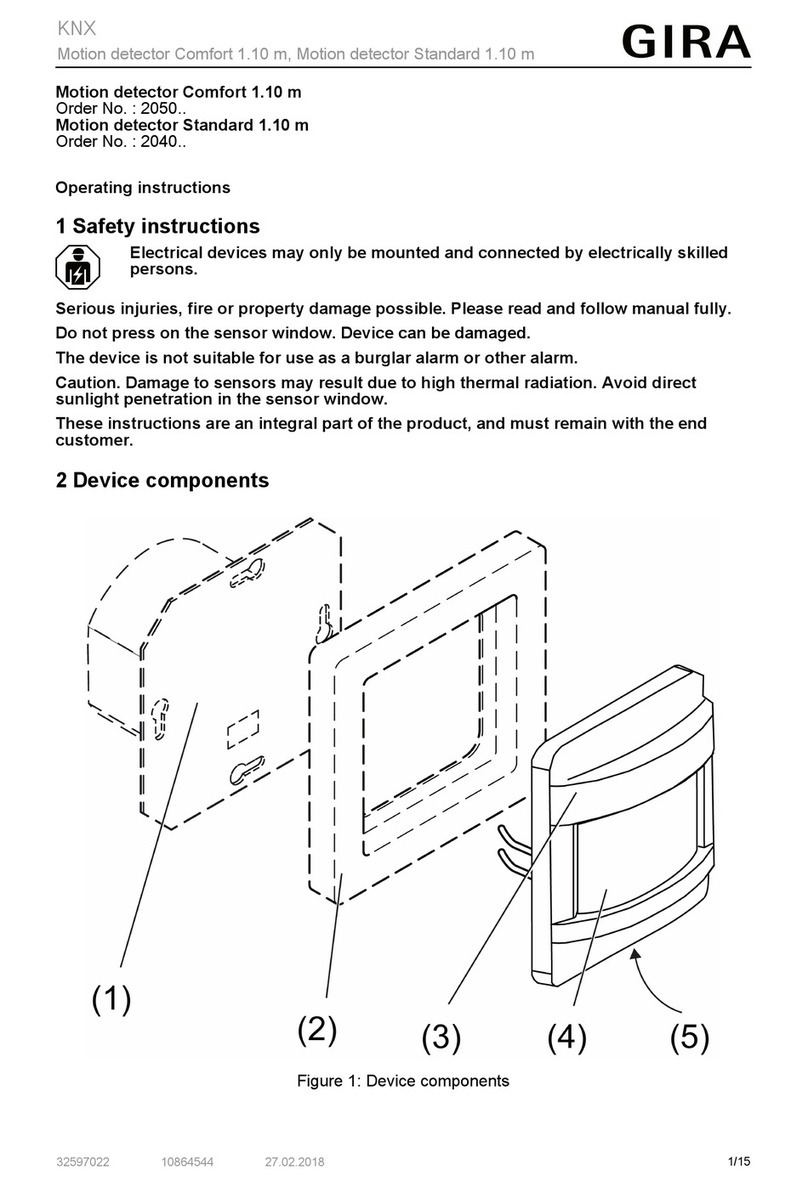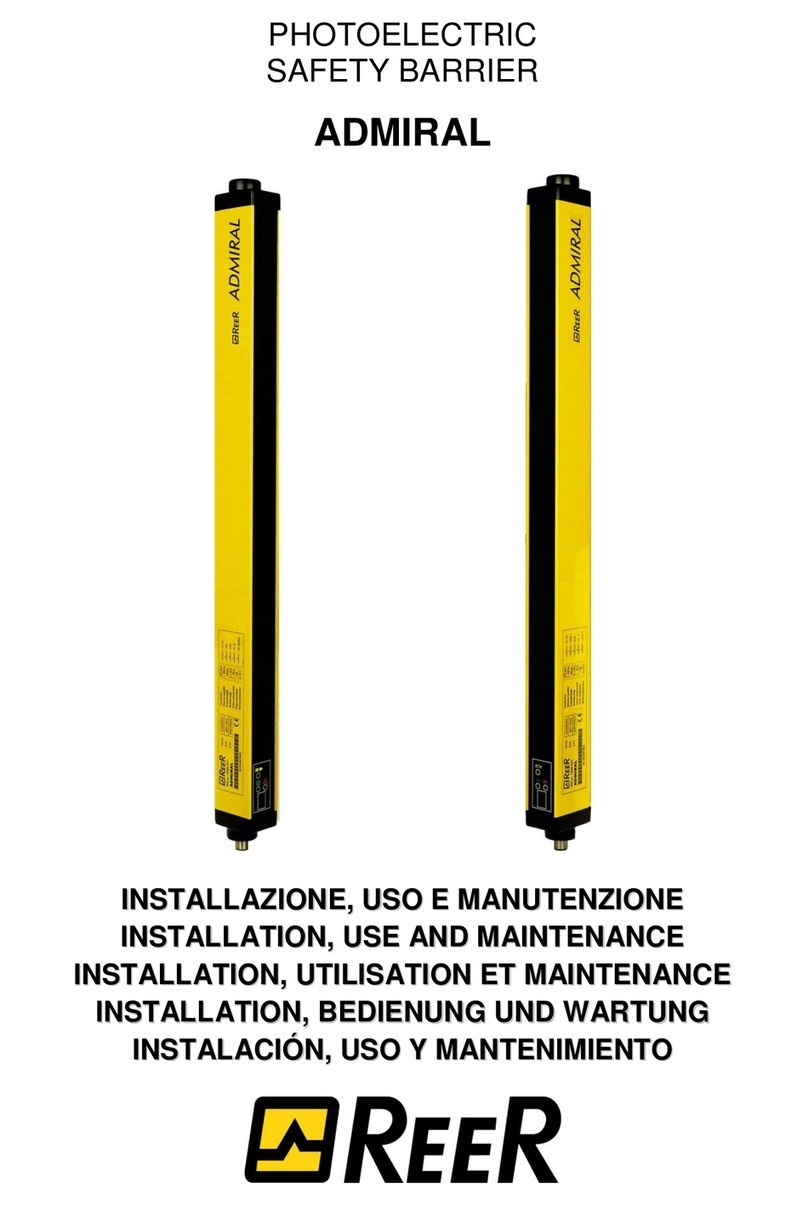DITEC LAB4 User manual

DITEC S.p.A.
Via Mons. Banfi, 3 - 21042 Caronno Pertusella (VA) - ITALY
Tel. +39 02 963911 - Fax +39 02 9650314
www.ditec.it - [email protected]
LAB4
IP1936
rev. 2008-03-03
Manuale di
installazione
fotocellula LAB4.
PEDFGB
I
Installation
manual for LAB4
photocell.
Manuel de
installation
cellule
photoélectique
LAB4.
Installation-
handbuch für
Lichtschranke
LAB4.
Manual de
instalaciòn para
fotocélula LAB4.
Manual de
instalação para
fotocélula LAB4.
Fig. 1
Fig. 2
Installazione frontale
Frontal installation
Installazione laterale
Side installation

2
LAB4 - IP1936
0 1
-+
24 V
TX
0
JP1
1
-+
24 V
RX
LED
Fig. 3 Fig. 4
RX
D
C
50
148
126
26
26
30
106
91,55 29,5
Fig. 5

3LAB4 - IP1936
AVVERTENZE GENERALI PER LA SICUREZZA
Il presente manuale di installazione è rivolto esclusivamente a
personale professionalmente competente. Leggere attentamente
le istruzioni prima di iniziare l’installazione del prodotto. Una errata instal-
lazione può essere fonte di pericolo. I materiali dell’imballaggio (plastica,
polistirolo, ecc.) non vanno dispersi nell’ambiente e non devono essere
lasciati alla portata dei bambini in quanto potenziali fonti di pericolo.
Prima di iniziare l’installazione verificare l’integrità del prodotto. Per
l’eventuale riparazione o sostituzione dei prodotti dovranno essere uti-
lizzati esclusivamente ricambi originali. E’ necessario conservare queste
istruzioni e trasmetterle ad eventuali subentranti nell’uso dell’impianto.
1. DATI TECNICI
Alimentazione 24 V= / 24 V~
Assorbimento 50 mA max
Portata 30 m max
Uscita contatto N.C. 24 V / 1A
Temperatura -20° C / +55° C
Grado di protezione IP55
2. UTILIZZO FOTOCELLULA COME DISPOSITIVO DI SICUREZZA
Le fotocellule LAB4 servono per proteggere eventuali zone di schiac-
ciamento, cesoiamento, convogliamento e di pericolo in genere della
porta o cancello motorizzati.
(Fig. 3) Collegare il contatto N.C. ai contatti di sicurezza del
quadro elettronico.
3. RIFERIMENTI ILLUSTRAZIONI
RX Ricevitore
TX Trasmettitore
LED Segnalazione attivazione uscita
4. INSTALLAZIONE
Le fotocellule devono essere installate rispettando le normative e le
direttive in vigore.
Posizionare il ricevitore RX ed il trasmettitore TX in asse ottico fra
loro. Il fissaggio può essere fatto direttamente a parete frontalmente o
lateralmente (fig. 2).
Eseguire i collegamenti elettrici come indicato in fig. 3.
5. INSTALLAZIONE DI DUE COPPIE DI FOTOCELLULE
Per evitare interferenze tra le due coppie di fotocellule, installare il
ricevitore RX ed il trasmettitore TX invertiti e con i raggi separati di
almeno 500 mm.
6. PORTATA MASSIMA
Le fotocellule LAB4 sono fornite con una portata massima di circa 10 m.
Per aumentare la portata fino a 30 m impostare JP1=OFF sul ricevitore
RX (fig. 3).
7. VERIFICA DI FUNZIONAMENTO
Chiudere la fotocellula con il frontalino e applicare esternamente l’etichetta
filtro di attenuazione.
Interrompere il fascio e verificare la commutazione del relè (acustica-
mente) e l’accensione del LED sul ricevitore RX.
L’etichetta filtro di attenuazione simula condizioni ambientali sfavorevoli.
Terminate le verifiche rimuovere l’etichetta filtro.
8. UTILIZZO FOTOCELLULA COME DISPOSITIVO DI COMANDO
(fig. 5)
- Tagliare la pista contrassegnata dal simbolo sul lato saldatura
del ricevitore RX.
- Ponticellare i punti contrassegnati [C] e [D].
Il contatto N.C. (fig. 3) diventa un contatto N.O. e deve essere col-
legato ai morsetti 1-3 (apertura) o 1-5 (passo-passo) del quadro elettronico.
9. PIANO DI MANUTENZIONE (ogni 6 mesi)
Per un corretto funzionamento delle fotocellule:
- mantenere pulite le superfici esterne del ricevitore RX e del tra-
smettitore TX;
- verificare che interrompendo il fascio (accensione del LED sul rice-
vitore RX), il cancello arresti il movimento o esegua la riapertura.
IGENERAL SAFETY PRECAUTIONS
This installation manual is intended for professionally competent
personnel only. Read the instructions carefully before beginning
to install the product. Incorrect installation may be a source of danger.
Packaging materials (plastic, polystyrene, etc.) must not be allowed to
litter the environment and must be kept out of the reach of children for
whom they may be a source of danger. Before beginning the installation
check that the product is in perfect condition. For repairs or replacements
of product only original spare parts must be used. These instruction must
be kept and forwarded to all possible future user of the system.
1. TECHNICAL DATA
Power supply 24 V= / 24 V~
Absorption 50 mA max
Range 30 m max
Output N.C. 24 V / 1A
Temperature -20° C / +55° C
Degree of protection IP55
2. USE OF THE PHOTOCELL AS SECURITY DEVICE
The LAB4 photocells may be used for protect against compression,
shearing, trapping and general danger areas of the motorized door
or gate.
(Fig. 3) Connect the N.C. contact to the safety or stop contacts
of the electronic panel.
3. REFERENCES
RX Receiver
TX Transmitter
LED Output activation signal
4. INSTALLATION
Photocells must be installed in compliance with current regulations and
directives.
Optically align RX and TX. Securing may be made either directly on the
wall frontally or sideways (fig. 2).
Wire up as shown in fig. 3.
5. INSTALLATION OF TWO PAIRS OF PHOTOCELLS
In order to avoid interferences between the two pairs of photocells, it
is advisable to install RX and TX inverted and with a distance between
the rays of at least 500 mm.
6. MAXIMUM RANGE
The LAB4 photocells are supplied with a max range of ca 10 m.
To increase the range up to 30 m, set JP1=OFF on the RX receiver
(fig. 3).
7. CHECKING FOR PROPER OPERATION
Close the photocell with the cover and affix the dimming filter sticker
on the outside.
Break off the beam and check for tripping of the relay (audible signal)
and coming on of LED on RX.
The damping filter label is intended to simulate unfavourable environmen-
tal conditions. Upon checks being completed, remove the filter label.
8. USE OF THE PHOTOCELL AS CONTROL DEVICE (fig. 5)
- Cut the track marked by on the weld side of RX.
- Make a soft-tin jumper between points [C] and [D].
The NC contact (fig. 3) becomes a NO contact and must
be connected to terminals 1-3 (opening) or 1-5 (step-by-step) of the
electronic panel.
9. MAINTENANCE SCHEDULE (every 6 months)
For proper photocell operation:
- keep the external surfaces of RX and TX always clean;
- check that breaking off of the beam (coming on of LED on RX)
causes gate to stop or reopen.
GB

4
LAB4 - IP1936
DF CONSIGNES GENERALES DE SECURITE
Cette notice d’installation est destinée exclusivement aux pro-
fessionels qualifiés. Lire attentivement les instructions avant de
procéder à l’installation du produit. Une installation erronée peut être
source de danger. Les materiaux de l’emballage (plastique, polystyréne,
etc ne doivent pas être abandonnés dand la nature et ne doivent pas
être laissés à la portée des enfants, car ils sont une source potentielle
de danger. Avant de procéder à l’installation, vérifier l’integrité du produit.
En cas de réparation ou de remplacement des produits, les piéces de
rechange originales doivent impérativement être utilisées. Il est indis-
pensable de conserver ces instructions et de les transmettre à d’autres
utilisateurs éventuels de ce systéme.
1. DONNEES TECHNIQUES
Alimentation 24 V= / 24 V~
Absorption 50 mA max
Portée 30 m max
Sortie N.C. 24 V / 1A
Température -20° C / +55° C
Degré de protection IP55
2. UTILISATION PHOTOCELLULE EN GUISE DISPOSITIF
DE SÉCURITÉ
Les photocellules LAB4 servent à protéger les zones éventuelles d’écra-
sement, de cisaillement, d’entraînement et de danger en général, de la
porte ou du portail automatisés.
(Fig. 3) Relier le contact N.C. aux contacts de sécurité ou
d’arrêt du tableau electronique.
3. RÉFÉRENCES ILLUSTRATIONS
RX Récepteur
TX Emetteur
LED Signalisation activation de sortie
4. INSTALLATION
Les photocellules doivent être installées selon les normes et les direc-
tives en vigueur. Positionner RX et TX sur leur axe optique. La fixation
peut s’effectuer au mur de front or latéralement (fig. 2). Effectuer les
raccordements électriques selon les indications de la fig. 3.
5. INSTALLATION DE DEUX PAIRES DE PHOTOCELLULES
Pour éviter les interférences entre les deux paires de cellules photoé-
lectriques, installer RX et TX intervertis et avec les rayons distants d’au
moins 500 mm.
6. PORTÉE MAXIMUM
Les cellules photoélectriques LAB4 sont fournies avec une portée
maximum de 10 mètres environ. Pour augmenter la portée jusqu’à 30
mètres, imposer JP1=OFF de RX (fig. 3).
7. VÉRIFICATION DU FONCTIONNEMENT
Fermer la photocellule avec le volet avant et appliquer l’étiquette du filtre
d’atténuation à l’extérieur. La plaque avant et le filtre d’atténuation étant
en place, interrompre le faisceau et vérifier la commutation du relais
(signalisation sonore) et l’allumage de la LED située sur RX.
Le filtre d’atténuation simule les conditions ambiantes défavorables.
Une fois les contrôles terminés, enlever le filtre.
8. UTILISATION PHOTOCELLULE EN GUISE DE COMMANDE
(fig. 5)
- Couper la piste repérée par sur le côté soudure de RX.
- Ponter les points [C] et [D].
Le contact N.C. (fig. 3) devient N.O. et doit être relié aux bornes
1-3 (ouverture) ou 1-5 (pas à pas) du tableau electonique.
9. PLAN D’ENTRETIEN (tous les 6 mois)
Pour le bon fonctionnement des photocellules:
- veiller à ce que les surfaces extérieures de RX et TX soient bien
propres;
- vérifier que le portail s’arrête ou rouvre si l’on interrompt le faisceau
(allumage de la LED située sur RX).
ALLGEMEINE SICHERHEITSHINWEISE
Das vorliegende Installationshandbuch ist ausschliesslich für
Fachpersonal bestimmt. Vor Einbaubeginn sind die Anweisungen
sorgfältig durchzulesen. Falscher Einbau kann Gefahr mit sich bringen.
Das Verpackunsmaterial (Kunststoff, Polystyrol, usw.) ist vorschriftsmä-
ßig zu entsorgen. Es ist von Kindern fernzuhalten, da es eine Gefahr
für sie bedeutet. Vor Beginn der Montage ist der einwandfreie Zustand
des Produkts zu überprüfen. Bei Reparatur und Austausch sind aus-
schliesslich Originalersatzteile zu verwenden. Die Hinweise sind sicher
aufzubewahren und auch allen weiteren Benutzern der Anlage zur
Verfüngung zu stellen.
1. TECHNISCHEN DATEN
Spannungsversorgung 24 V= / 24 V~
Stromaufnahme 50 mA max
Reichtweite 30 m max
Aufgang N.C. 24 V / 1A
Temperatur -20° C / +55° C
Schutzgrad IP55
2. VERWENDUNG PHOTOZELLE ALS SICHERHEIT-
SEINRICHTUNG
Die Photozellen LAB4 werden eingesetzt für dem Schutz vor Quetsch-,
Scher-, Einzieh- und sonstigen Gefahrbereichen des Tores nach Mon-
tage des Antriebs.
(Abb. 3) Im Ruhezustand geschlossenen Kontakt an die Si-
cherheits- oder Stop-Konakte der Steuerung anschließen.
3. VERWEISE AUF ABBILDUNGEN
RX Empfänger
TX Sender
LED Signalisierung des aktivierten Ausgangs
4. INSTALLATION
Die Photozellen müssen unter Einhaltung der geltenden Gesetze und
Richtlinien installiert werden. Positionieren Sie RX und TX in Achse
zueinander. Die Befestigung muss unmittelbar an der Wand, stirnseitig
oder seitlich (fig. 2). Stellen Sie die elektrischen Anschlüsse gemäß den
Angaben in der Abb. 3 her.
5. INSTALLATION ZWEIER PHOTOZELLENPAARE
Um Interferenzen zwischen den zwei Lichtaschrankenpaaren zu
vermeiden, sind RX und TX ausgekreuzt zu installieren und die Strahlen
mit mindestens 500 mm Abstand zu halten.
6. MAXIMALE REICHWEITE
Die Lichtschranken LAB4 werden mit einer Reichweite von 10 m
geliefert. Um die Reichweite auf 30 m zu erhöhen, JP1=OFF des RX
einstellen (Abb. 3).
7. ÜBERPRÜFUNG DES BETRIEBS
Photozelle mit den Deckeln schließen und außen das Etikett Dämpfung-
sfilter aufkleben. Stellen Sie durch Unterbrechung des Lichtbündels die
Umschaltung des Relais (durch Hören) sowie das Aufleuchten der LED
auf RX sicher. Der Dämpfungsfilter simuliert ungünstige Umgebungsbe-
dingungen. Entfernen Sie den Filter nach Abschluss der Kontrollen.
8. EINSATZ DER PHOTOZELLE ALS BEFEHLSEINRICHTUNG
(Abb. 5)
- Schneiden Sie die durch identifizierte Spur auf der Lötseite
von RX ein.
- Brücken Sie die Punkte [C] und [D] mit Zinn.
Der im Ruhezustand geschlossenen Kontakt (Abb. 3) wird zu
einem stromlos offenen Kontakt und muss an die Klemmen 1-3 (Öffnung)
oder 1-5 (Schrittbetrieb) der Steuerung angeschlossen werden.
9. WARTUNGSPLAN (alle 6 Monate)
Zur Gewährleistung des korrekten Betriebs der Photozellen:
- Halten Sie die Oberflächen von RX und TX stets perfekt sauber;
- Stellen sie sicher, dass das Tor beim Unterbrechen des Lichtbün-
dels (Angehen der LED auf RX) stoppt und sich wieder öffnet.

5LAB4 - IP1936
PE ADVERTENCIAS GENERALES DE SEGURIDAD
El presente manual de instalaciòn està destinado exclusivamente
a professionales calificados. Leer atentamente las instrucciones
antes de comenzar la instalaciòn del producto. Una instalaciòn incorrecta
puede ser causa de peligro. El material de embalaje (plàstico, poliestirol,
etc.) debe desecharse sin causar daño al medio ambiente y mantener-
se fuera del alcance de los niños, porque es una potencial fuente de
peligro. Antes de comenzar la instalaciòn verificar que el producto esté
integro. Para cualquier reparaciòn o sustituciòn del producto, utilizar
exclusivamente repuestos originales. Conservar estas instrucciones y
entregarlas a futuros usuarios.
1. DATOS TECNICOS
Alimentaciòn 24 V= / 24 V~
Absorbimiento 50 mA max
Alcance 30 m max
Salida N.C. 24 V / 1A
Temperatura -20° C / +55° C
Grado de protección IP55
2. UTILIZACIÓN FOTOCÉLULA COMO DISPOSITIVO DE
SEGURIDAD
Las fotocélulas LAB4 sirven para proteger a toda posible zona de
aplastamiento, cizallamiento, deslizamiento o peligro en general de la
puerta o verja motorizadas.
(Fig. 3) Conectar el contacto N.C. con los contactos de segu-
ridad o de parada del tablero electronico.
3. REFERENCIAS ILUSTRACIONES
RX Receptor
TX Transmisor
LED Señalización activación de salida
4. INSTALACIÓN
Las fotocélulas deber ser instaladas respetando las normativas y
directivas en vigor. Posicionar RX y TX en eje óptico entre ellos. La
fijación puede ser realizada directamente en la pared frontalmente o
lateralmente (fig. 2).
Efectuar las conexiones eléctricas según lo indicado en las fig. 3.
5. INSTALACIÒN DE DOS PARES DE FOTOCÉLULAS
Para evitar interferencias entre las dos parejas de fotocélulas, instalen
RX y TX invertidos y con los rayos separados por al menos 500 mm.
6. ALCANCE MAXIMA
Las fotocélulas LAB4 están provistas de una capacidad máxima de
alrededor de 10 m. Para aumentar la capacidad hasta los 30 m configure
JP1=OFF de RX (fig. 3).
7. VERIFICACIÓN DEL FUNCIONAMIENTO
Cerrar la fotocélula con el frentero y aplicar la etiqueta del filtro de
atenuación al exterior.
Interrumpir el haz y verificar la conmutación del relé (señalización
sonora) y el encendido del LED situado en RX. El filtro de atenuación
simula las condiciones ambientales desfavorables. Concluidos los
controles, quitar el filtro.
8. UTILIZACIÓN FOTOCÉLULA COMO DISPOSITIVO DE
MANDO (fig. 5)
- Cortar la pista marcada por en el lado de soldadura de RX.
- Puentear los puntos [C] y [D] con estaño.
El contacto N.C. (fig. 4) se vuelve N.A. y debe ser conectado
con los bornes 1-3 (abertura) o 1-5 (paso a paso) del tablero electronico.
9. PLANO DE MANTENIMIENTO (cada 6 meses)
Para un correcto funcionamiento de las fotocélulas:
- mantener limpias las superficies externas de RX y TX;
- verificar que, interrumpiendo el haz (encendido del LED situado
en RX), la cancela se detenga o reabra.
ADVERTÊNCIAS GERAIS PARA A SEGURANÇA
O presente manual de instalação é dirigido exclusivamente ao
pessoal profissionalmente competente. Ler atentamente as in-
struções antes de iniciar a instalação do produto. Uma errada instalação
pode ser fonte de perigo. Os materiais da embalagem (plástico, polistire-
no, etc.) não devem ser jogados no ambiente e não devem ser deixados
ao alcance de crianças pois potenciais fontes de perigo. Antes de iniciar
a instalação verificar a integridade do produto. Para a eventual reparação
ou a substituição dos produtos deverão ser utilizadas exclusivamente
peças de reposição genuínas. Estes instrução deve ser mantida e deve
ser remetida a todo possível usuário futuro do sistema.
1. CARACTERÍSTICAS TÉCNICAS
Alimentação 24 V= / 24 V~
Absorção 50 mA max
Gama 30 m max
Produção N.C. 24 V / 1A
Temperatura -20° C / +55° C
Grau de proteção IP55
2. USO FOTO-CÉLULA COMO DISPOSITIVO DE SEGURANÇA
As foto-células LAB4 servem para proteger eventuais zonas de
esmagamento, corte, envolvimento e perigo em geral da porta o portão
motorizados.
(Fig. 3) Ligar o contacto N.C. aos contactos de segurança do
quadro electrónico.
3. REFERÊNCIAS DE ILUSTRAÇÕES
RX Receptor
TX Transmissor
LED Sinalização de activação da saída
4. INSTALAÇÃO
As foto-células devem ser instaladas respeitando as normas e as
directrizes em vigor.
Posicionar RX e TX no eixo óptico entre si. A fixação pode ser feita
directamente na parede frontal o lateralmente (fig. 2).
Realizar as ligações eléctricas como indicado na fig. 3.
5. INSTALAÇÃO DE DOIS PARES DE FOTOCÉLULAS
Para evitar interferências entre os dois pares de células de detecção, in-
stalar RX e TX invertidos e com os raios separados pelo menos 500 mm.
6. GAMA MÁXIMA
As células de detecção LAB4 são fornecidas com uma capacidade
máxima de cerca 10 m. Para aumentar a capacidade até 30 m configurar
JP1=OFF di RX (fig. 3).
7. VERIFICAÇÃO DE FUNCIONAMENTO
Fechar a foto-célula com o painel frontal e aplicar por fora a etiqueta
do filtro de atenuação.
Interromper o feixe e verificar a comutação do relé (acusticamente) e o
acendimento do LED em RX.
A etiqueta filtro de atenuação simula condições ambientais desfavoráveis.
Depois das verificações remover a etiqueta do filtro.
8. USO FOTO-CÉLULA COMO DISPOSITIVO DE COMANDO
(fig. 5)
- Cortar a pista marcada de no lado de soldadura de RX.
- Ligar com pontes e com estanho os pontos [C] e [D].
O contacto N.C. (fig. 4) torna-se N.O. , e é ligado aos bornes
1-3 (abertura) ou 1-5 (passo-a-passo) do quadro electronico.
9. PLANO DE MANUTENÇÃO (cada 6 meses)
Para um funcionamento correcto das foto-células:
- manter limpa as superfícies externas de RX e TX;
- verifique que interrompendo o feixe (acendimento do LED em
RX), o portão bloqueie-se ou se reabra.

6
LAB4 - IP1936
Tutti i diritti sono riservati
I dati riportati sono stati redatti e controllati con la massima cura. Tuttavia non possiamo assumerci alcuna responsabilità per
eventuali errori, omissioni o approssimazioni dovute ad esigenze tecniche o grafiche.
All right reserved
All data and specifications have been drawn up and checked with the greatest care. The manufacturer cannot however take any
responsibility for eventual errors, ommisions or incomplete data due to technical or illustrative purposes.
Touts droits reservés
Les informations mentionnées dans ce catalogue ont été controlées avec la plus grande attention. Toutefois, nous déclinos toute re-
sponsabilité en cas d’erreurs, omissions ou approximations dépendant d’exigences techniques ou graphiques.
Alle Rechte vorbehalten
Die wiedergegebenen Daten wurden mit höchster Sorgfalt zusammengestellt und überprüft. Es kann jedoch keinerlei Verantwor-
tung für eventuelle Fehler, Auslassungen oder Näherungen, die technischen oder graphischen Notwendigkeiten zuzuschreiben
sind, übernommen werden.
Todos los derechos son reservados
Los datos que se indican han sido redactados y controlados con la màxima atenciòn. Sin embargo no podemos asumir ninguna
responsabilidad por eventuales errores, omisiones o aproximaciones debidas a exigencias técnicas o gràficas.
Todos os direitos são reservados
Os dados indicados foram redigidos e controlados com o máximo cuidado. Contudo, não podemos assumir qualquer responsabilidade
por eventuais erros, omissões ou aproximações devidas a exigências técnicas ou gráficas.
Table of contents
Other DITEC Security Sensor manuals
